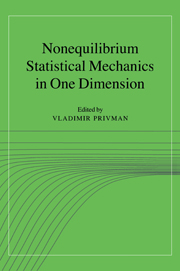Book contents
- Frontmatter
- Contents
- Contributors
- Preface
- Part I Reaction-Diffusion Systems and Models of Catalysis
- Part II Kinetic Ising Models
- Part III Ordering, Coagulation, Phase Separation
- Part IV Random Adsorption and Relaxation Processes
- Part V Fluctuations in Particle and Surface Systems
- Part VI Diffusion and Transport in One Dimension
- Part VII Experimental Results
- Index
- Abbreviations
Part I - Reaction-Diffusion Systems and Models of Catalysis
Published online by Cambridge University Press: 18 December 2009
- Frontmatter
- Contents
- Contributors
- Preface
- Part I Reaction-Diffusion Systems and Models of Catalysis
- Part II Kinetic Ising Models
- Part III Ordering, Coagulation, Phase Separation
- Part IV Random Adsorption and Relaxation Processes
- Part V Fluctuations in Particle and Surface Systems
- Part VI Diffusion and Transport in One Dimension
- Part VII Experimental Results
- Index
- Abbreviations
Summary
Editor's note
The first three chapters of the book cover topics in reactions and catalysis. Chemical reactions comprise a vast field of study. The recent interest in models in low dimension has been due to the importance of two-dimensional surface geometry, appropriate, for instance, in heterogeneous catalysis. In addition, several experimental systems realize 1D reactions (Part VII).
The classical theory of chemical reactions, based on rate equations and, for nonuniform densities, diffusion-like differential equations, frequently breaks down in low dimension. Recent advances have included the elucidation of this effect in terms of fluctuation-dominated dynamics. Numerous models have been developed and modern methods in the theory of critical phenomena applied. The techniques employed range from exact solutions to renormalization-group, numerical, and scaling methods.
Models of reactions in 1D are also interrelated with many other 1D systems ranging from kinetic Ising models (Part II) and deposition (Part IV) to nucleation (Part III). Chapter 1 reviews the scaling theory of basic reactions and summarizes numerous results. One of the methods of obtaining exact solutions in 1D, the interparticle-distribution approach, is reviewed in Ch. 2. Other methods for deriving exact results in 1D are not considered in this Part. Instead, closely related systems and solution techniques based on kinetic Ising models and cellular automata are presented in Chs. 4, 6, 8. Coagulation models in Ch. 9 employ methods that have also been applied to reactions.
More complicated models of catalysis, directed percolation, and kinetic phase transitions, are treated in Ch. 3.
- Type
- Chapter
- Information
- Publisher: Cambridge University PressPrint publication year: 1997



